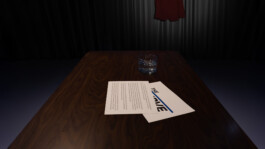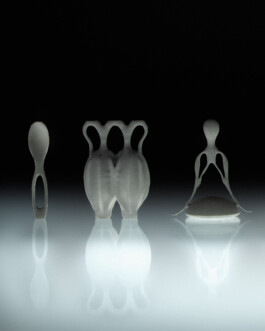
Ornatus Typeface, 2024
The experimental typeface Ornatus explores ornamentation as a narrative tool. Its forms are derived through the deconstruction and reconstruction of elements found in wrought iron details and arabesque constellations. Ornatus encompasses various degrees of ornamentation, with its most elaborate form approaching asemic writing – characters without semantic meaning that represent a form of communication beyond the literal, exploring the boundary between abstraction and the concrete. Glyphs overlap and form unexpected combinations; new patterns, interweavings, and layers of meaning emerge. A type specimen, including speculative use cases.
Böse Bauten, 2023
Böse Bauten is a video project that examines Nazi-era architecture, with a focused exploration of Berlin's Tempelhof Airport. Constructed in 1934 under the direction of Ernst Sagebiel, this airport was a pivotal element in Hitler's vision for 'Germania,' symbolizing the architectural and ideological ambitions of that era. The work contrasts historical audio and archival sounds from propaganda events held at Tempelhof Airport with visuals of its current state of decay. The project seeks to highlight the lasting impact of Nazi architecture and capture the complexity of its legacy. Böse Bauten aims to offer insights into how such structures continue to influence the relationship between architecture and political ideology today.


My Mistake, Still a Great Night, 2024

My Mistake, Still a Great Night is an experimental exhibition that engages with the disruptive potential of "glitches" - unpredictable malfunctions, sudden protocol deviations, or errors in the (program) sequence. The exhibition employs the glitch as an instrument for critical reflection on established spaces, spatial structures, and prevailing linear narratives.
Upon entering, visitors are immersed in the remnants of a left-behind news broadcast studio: a recreated backdrop, an anchor's desk, cue cards, a glass of water with a lipstick stain, a left-behind blazer, and a teleprompter still running, showing the news script. A single-channel video collage of found footage depicting real glitch moments from politics, sports, and pop culture is projected onto a spherical surface, the studio backdrop behind the presenter's desk, forming the contextual and spatial frame of the scene. The choreographed film footage interacts with the staged script, as the moderator's voice, still commenting on what is being shown, descends from conventional reporting into a raw, poetic manifesto presenting the "error" as a revolutionary rupture.
Behind a curtain lies the backstage area, a windowless environment with control room cubicles, housing multiple monitors showing the staged news broadcast. The abandoned studio becomes a transformative space where visitors shed their roles as passive observers. They enter the scenes and morph into moderators and disruptors of the broadcast, playing with the borders of backstage and stage: My Mistake, Still a Great Night.

In-Output, 2023

Ornatus Typeface, 2024
The experimental typeface Ornatus explores ornamentation as a narrative tool. Its forms are derived through the deconstruction and reconstruction of elements found in wrought iron details and arabesque constellations. Ornatus encompasses various degrees of ornamentation, with its most elaborate form approaching asemic writing – characters without semantic meaning that represent a form of communication beyond the literal, exploring the boundary between abstraction and the concrete. Glyphs overlap and form unexpected combinations; new patterns, interweavings, and layers of meaning emerge. A type specimen, including speculative use cases.
Böse Bauten, 2023
Böse Bauten is a video project that examines Nazi-era architecture, with a focused exploration of Berlin's Tempelhof Airport. Constructed in 1934 under the direction of Ernst Sagebiel, this airport was a pivotal element in Hitler's vision for 'Germania,' symbolizing the architectural and ideological ambitions of that era. The work contrasts historical audio and archival sounds from propaganda events held at Tempelhof Airport with visuals of its current state of decay. The project seeks to highlight the lasting impact of Nazi architecture and capture the complexity of its legacy. Böse Bauten aims to offer insights into how such structures continue to influence the relationship between architecture and political ideology today.



My Mistake, Still a Great Night, 2024
My Mistake, Still a Great Night is an experimental exhibition that engages with the disruptive potential of "glitches" - unpredictable malfunctions, sudden protocol deviations, or errors in the (program) sequence. The exhibition employs the glitch as an instrument for critical reflection on established spaces, spatial structures, and prevailing linear narratives.
Upon entering, visitors are immersed in the remnants of a left-behind news broadcast studio: a recreated backdrop, an anchor's desk, cue cards, a glass of water with a lipstick stain, a left-behind blazer, and a teleprompter still running, showing the news script. A single-channel video collage of found footage depicting real glitch moments from politics, sports, and pop culture is projected onto a spherical surface, the studio backdrop behind the presenter's desk, forming the contextual and spatial frame of the scene. The choreographed film footage interacts with the staged script, as the moderator's voice, still commenting on what is being shown, descends from conventional reporting into a raw, poetic manifesto presenting the "error" as a revolutionary rupture.
Behind a curtain lies the backstage area, a windowless environment with control room cubicles, housing multiple monitors showing the staged news broadcast. The abandoned studio becomes a transformative space where visitors shed their roles as passive observers. They enter the scenes and morph into moderators and disruptors of the broadcast, playing with the borders of backstage and stage: My Mistake, Still a Great Night.
